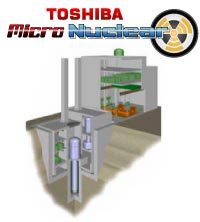
Unlike the lead- and sodium-cooled reactors, which Rosatom ultimately envisions as very large (1600+ MWe in the case of the case of the BN-series), the SVBR is designed as a small, modular, and passively-safe reactor.SVBR should have 90 gwd/ton (90 gigawatt days per ton of uranium. This is close to being twice as efficient with Uranium as existing light water reactors.)
The Oil Drum coverage of the SVBR
Source nextbigfuture
Hyperion Power Generation.
The reactor will weigh fifteen to 20 tons, depending on whether you're measuring just the reactor itself or the cask—the container that we ship it in—as well. It was specifically designed to fit on the back of a flatbed truck because most of our customers are not going to have rail. It's about a meter-and-a-half across and about 2 meters tall.
It uses uranium hydride. UH3 is the chemical formula. Low-enriched, about 10 percent [uranium isotope]-235, the rest is U-238.
We're leveraging the design of a very common reactor, called a TRIGA reactor. There are 60-something of those reactors around the world. They are the only reactor that the NRC has licensed for unattended operation, meaning it's so safe that you can literally walk away from it. It's walk-away safe.
Another big contender I have posted on before: the Toshiba Ultra-Small Nuclear Reactor

The 200 kilowatt Toshiba designed reactor is engineered to be fail-safe and totally automatic and will not overheat. Unlike traditional nuclear reactors the new micro reactor uses no control rods to initiate the reaction. The new revolutionary technology uses reservoirs of liquid lithium-6, an isotope that is effective at absorbing neutrons. The Lithium-6 reservoirs are connected to a vertical tube that fits into the reactor core. The whole whole process is self sustaining and can last for up to 40 years, producing electricity for only 5 cents per kilowatt hour, about half the cost of grid energy.
Read more about advancements from NRC
